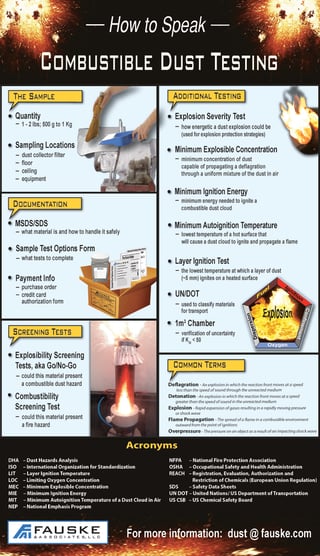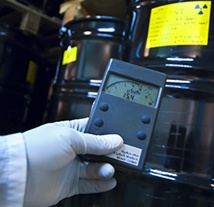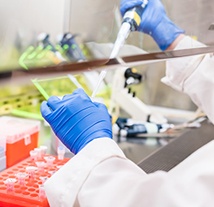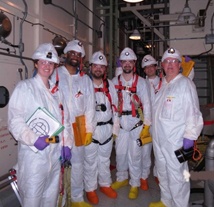By Ronald L. Allen, MS, PE, CSP, Senior Consulting Engineer, Fauske & Associates, LLC
Understanding the characteristics of combustible dusts is essential to ultimately managing the risks associated with the material. But, many questions need to be answered before valid samples can be taken and tested. Mistakes can lead to wasted time and money – or worse – incorrect assessment of risk. This blog provides a brief overview of essential factors.
1. Who Should Perform the Testing?
While many labs may claim the ability to conduct hazardous dust tests, the truth is that not all labs have the qualifications or experience to do so. Engagement of a laboratory that is ISO 17025 certified to perform the specific tests that are needed will assure high quality results. These internationally recognized labs also have the resources to explain test results and offer guidance to their clients.
2. What Tests to Perform?
Generally speaking, tests fall into three categories:
- Combustibility Screening Test: Commonly known as a “Go/No Go” test, this initial screen determines whether the particulate is “explosible”. If the material proves to be “explosible”, additional characterization should be completed to understand ignition sensitivity and explosion severity.
- Ignition Sensitivity Tests: These “before the ignition” tests are chosen based upon the environment and potential risks that may be present where the dust is generated, processed, conveyed, or stored. The most common tests answer the following questions:
- How much energy is required to ignite the dust? This test for Minimum Ignition Energy (MIE) is critical to determine if a dust can be ignited by low-energy sources like static electricity or if a higher energy source (e.g., sparking motors) would be necessary for ignition. Results are reported in millijoules (mJ).
- How much material must be suspended in the atmosphere before ignition can be supported? The test for Minimum Explosible Concentration (MEC) is often compared to the Lower Explosive Level (LEL) for flammable vapors and liquids. Results are measured in grams per cubic meter (g/m3).
- At what temperature will airborne dust autoignite? The test for Minimum Ignition Temperature – Cloud (MIT) determines when airborne dust can ignite by contacting hot objects (e.g., oven cabinet surfaces, motors, overheated bearings) or heated environments. Results are reported in degrees of centigrade.
- At what temperature will layered dust autoignite? The test for Layer Ignition Temperature (LIT) determines when layered dust can ignite when in contact with heated surfaces (e.g., oven cabinet surfaces, motors, overheated bearings). Results are reported in degrees of centigrade.
- Explosion Severity Tests: These “after the ignition” tests determine how much energy is generated when a specific dust is ignited in a contained vessel. The test results are demanded when designing explosion protection equipment (e.g., explosion relief panels, chemical isolation systems) to mitigate the effects of an explosion involving a specific material. The most common tests answer the following questions:
- What is the maximum pressure that will be generated by a dust cloud explosion? Maximum Pressure (Pmax) is reported in bars (standard atmospheres) and is not normalized.
- What is the normalized speed of pressure rise created by the dust cloud explosion? The Deflagration Index (KSt) is reported in bar-meters/second (bar-m/sec).
3. Should Samples be Tested “As Received”?
ASTM International has published a series of standards (E1226, E1515, E2019, E1491, and E2021) that determine how dust samples should be tested for explosivity potentials and characteristics. Without exception, ASTM recommends that tested material have a particle size of <75 microns and a moisture content of <5%. In some cases, samples must be ground, sieved, and/or dried to meet these ASTM recommendations. Sizing and drying material often produces more conservative results than testing the material “as received”. Assuring consistent particle size and moisture content produces the consistent, reliable results needed for specifying explosion protection equipment (e.g., explosion vents, suppression systems). The conservative nature of the recommendations to test fine, dry material addresses many concerns about the potential for fines to accumulate in some location (e.g., duct elbow, dust collector, interior walls of bins) in the process or fine fugitive dust on elevated building surfaces like I-beams, pipes/ducts and light fixtures.
While the advantages of sizing and drying material are clear, there can also be value in testing particulate “as received” to understand how the material will behave in its specific native environment if particle segregation/classification did not take place. “As received” test data can be particularly beneficial when considering ignition sensitivity. For example, material that is sized and dried to meet ASTM recommendations may best represent the “worst case” dust characteristics that could be present inside of a dust collector where the most conservative protection techniques could be demanded. But, “as received” samples of the same material taken from an upstream location in the process where the particulate displays a larger particle size and/or increased moisture content could (for example) present a significantly higher minimum ignition energy (MIE) value than samples that have been sized and dried. The higher MIE value in the “as received” sample could justify reducing controls at the point of the process where the sample was taken. For example, static dissipative shoes could be required when working at the dust collector where lower MIE values could be expected, but the same precaution may not be warranted at the upstream location where an elevated MIE is documented.
Many firms choose to test material in both fashions – ground and dried (if needed) and “as received”.
4. Where to Take Samples?
Generally speaking, it is recommended that samples be taken from the “dirty” side of dust collectors since that material tends to include relatively dry, small particles. The “best samples” are taken from dust collectors as directed below in order of preference:
- Use non-sparking tools to scrape or otherwise remove the material directly from the dust collector filters or cartridges. This technique will increase the probability of collecting fine particles.
- If it is not feasible to remove the material directly from the dust collector filters or cartridges, “pulse” the dust collector prior to collecting the sample from a clean storage collection drum/container.
- If possible, avoid taking samples from the dust collection drum/container (e.g., 55 gallon drum) unless the drum/container has been emptied or cleaned before a “pulsed” sample is generated (see above). Otherwise, the sample will include a composite of material discharged from the dust collector that has the potential of including larger particles that may understate the risk posed by the material. Because of their mass, larger particles may “fall” into the collection drum/container without being collected onto the filters or cartridges. In this case, screening may be warranted to remove those coarse particles.
“Elevated surfaces” provide another preferred location to sample since smaller particle material tends to rise, disperse (aka, “float”), and collect on building steel, pipes, ductwork, and the tops of equipment. Often times, a vertical lift is required to safely access such areas for sampling purposes. Collecting samples from elevated surfaces is most appropriate in operations where dust collection systems do not exist.
Relatively dry, small particle material suitable for testing may also be found on the interior walls of bins and ductwork.
Generally speaking, the “age” of the sample is unimportant. The primary exception relates to metal dust. Since explosible characteristics of metal dust can be understated if the sample material is allowed to oxidize, it is advised that “fresh material” be sampled. These “fresh samples” should be tightly sealed to prevent entry of moisture that could lead to oxidation prior to testing.
5. How to Take Samples?
Use of non-sparking equipment (e.g., natural bristle brushes, plastic antistatic shovels, scoops, or dust pans) is recommended to collect samples. Samples should be collected in sealed plastic (e.g., Ziploc) bags or other sealed, non-conductive containers. Sample size requirements vary (100 – 1000 grams) dependent upon the test(s) that will be conducted. ISO 17025 – certified labs usually provide sampling instructions to clients and may even provide test kits. Samples should be clearly labeled to identify the location where they were taken.
6. How to Transport Samples?
Entities shipping combustible dust samples should consult DOT Hazardous Materials regulations prior to shipping samples. Warning labels or special shipping precautions are not needed for most common, small volume (e.g., <1000 grams) particulate samples, but exceptions can exist. Labs receiving the samples will have requirements about documentation that must accompany sample shipments.
7. Common Problems Associated with Combustible Dust Sampling
- Not submitting adequate sample size or sample quantity to complete needed tests (lab should assist with direction or provide a kit)
- Submitting incomplete test request forms
- Samples not collected from proper locations (e.g., takes sample from floor or easily accessed locations where particle size tends to be large and may be moist)
Summary
Preparing and executing a strategy for combustible dust sampling and testing is a manageable task but can present challenges for the unindoctrinated. Partnering with an ISO 17025 laboratory can help address questions about jargon and recommended practices. More importantly, such expert advice from a certified lab can ultimately help reduce and manage risks.
For more information, please contact Ron Allen at Allen@fauske.com, 608-698-6105 or Dr. Ashok Dastidar at dastidar@fauske.com at 630-887-5249.










